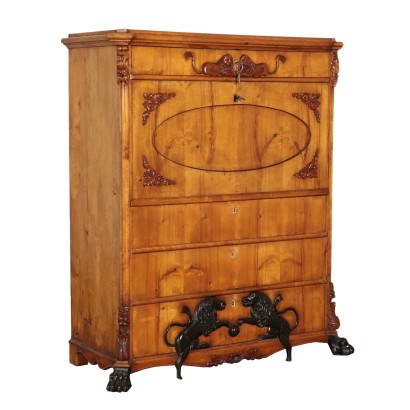Biedermeier Secretaire, Marple and Ebony, Austria 19th Century
Features
Style: Biedermeier (1815-1848)
Age: 19th Century / 1801 - 1900
Origin: Austria
Main essence: Maple
Material: Ebony Wood
Description
Biedemaier marple secretaire. Supported by four feet of which the frontal ones carved with lion features and made with ebonized wood. The lower band is moulded and framed and ornated in the middle with a leafy scrolls carving. It has three drawers surmounted by a folding door that hides an internal glass cabinet with drawers and secret compartments. In the middle there is a small door framed by two twisted colums above which there is a decal represnting a soldier behind whom we can see a flag with the colors of the Archduchy of Austria. The folding door is embellished with wooden leafy carving also taken at the base and at the top pf the pillars. Curious is the couple of lions: tame on the oundermount band, rampant and made with ebonized wood on the lower drawer.
Product Condition:
Fair condition. Wear consistent with age and use.
Dimensions (cm):
Height: 147
Width: 130
Depth: 59
Certificate issued by: Enrico Sala
Additional Information
Style: Biedermeier (1815-1848)
The Biedermeier style is a style that characterizes German and Austrian furniture between approximately 1815 (Congress of Vienna) and 1848 (beginning of the revolutionary movements).Its main features are essentiality and functionality, and the home destination.
Biedermeier first took on a derogatory connotation: the word derives from "Bieder", or "simpleton" and from "Meir", one of the most common German surnames at the time and was the name of a "simpleton" character in a comedy of Ludwig Eichrodt.
This term meant the conservative petty bourgeois, concerned only with his own family reality.
Even if in a derogatory way, the term represents exactly the new socio-political situation in which the bourgeois is forced or resigned to renounce the yearnings for democracy and freedom.
The center of life therefore becomes the home, no longer characterized by unbridled luxury but comfortable and practical.
Consequently, Biedermeier furniture are functional, comfortable and easily achievable products.
The style is an evolution of the Empire style towards greater simplification, without ornamental and antique elements, lighter, linear and curved shapes, lighter colors.
Find out more about the Biedermeier style with our insights:
Biedermeier, the comfortable and practical style
Biedermeier, when a style d 'furniture transforms an environment
FineArt: group eight Biedermeier applique, Vienna, 1820-1830
FineArt: Biedermeier Reifenluster, Vienna, c. 1820-1830 - Viennese chandelier





































